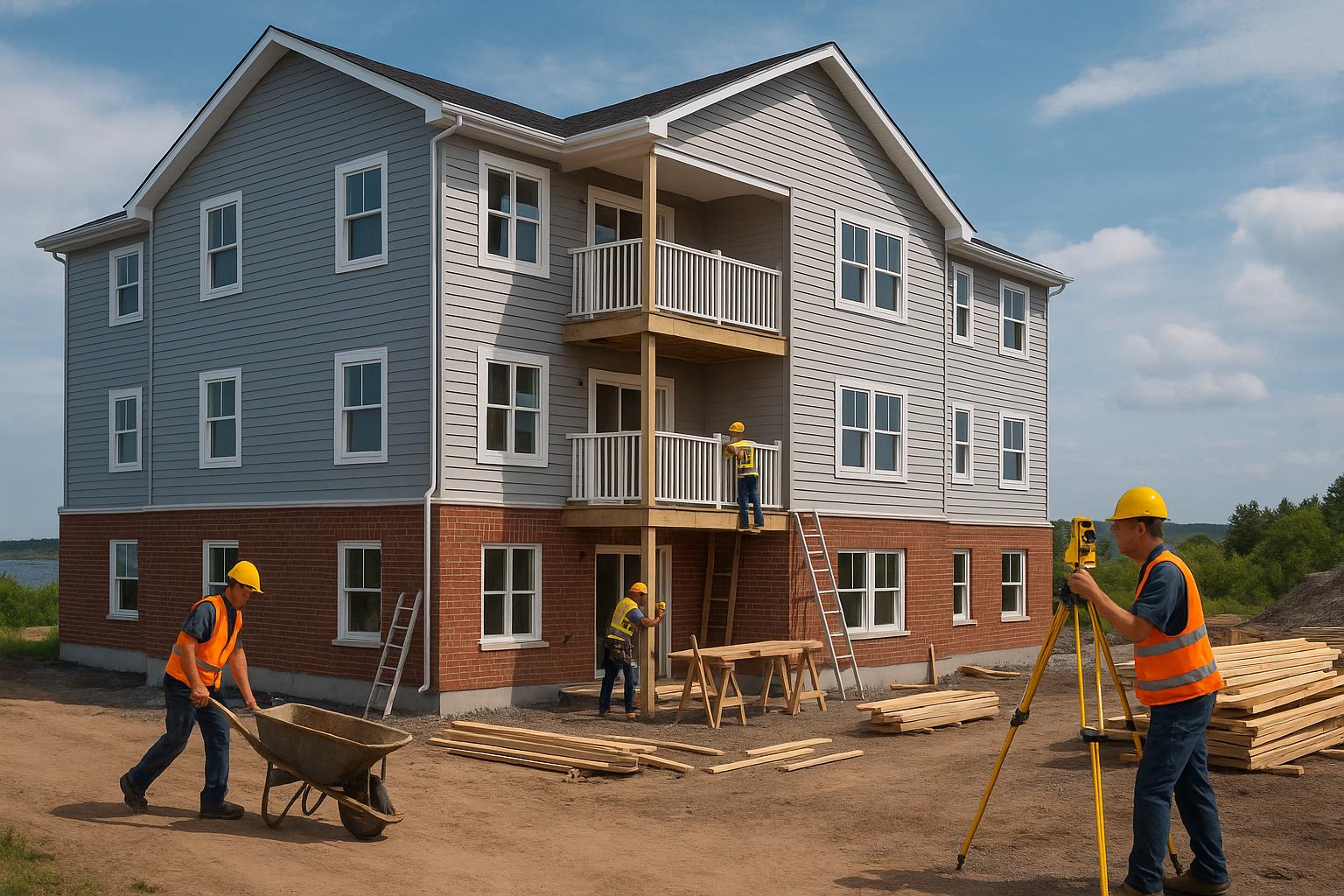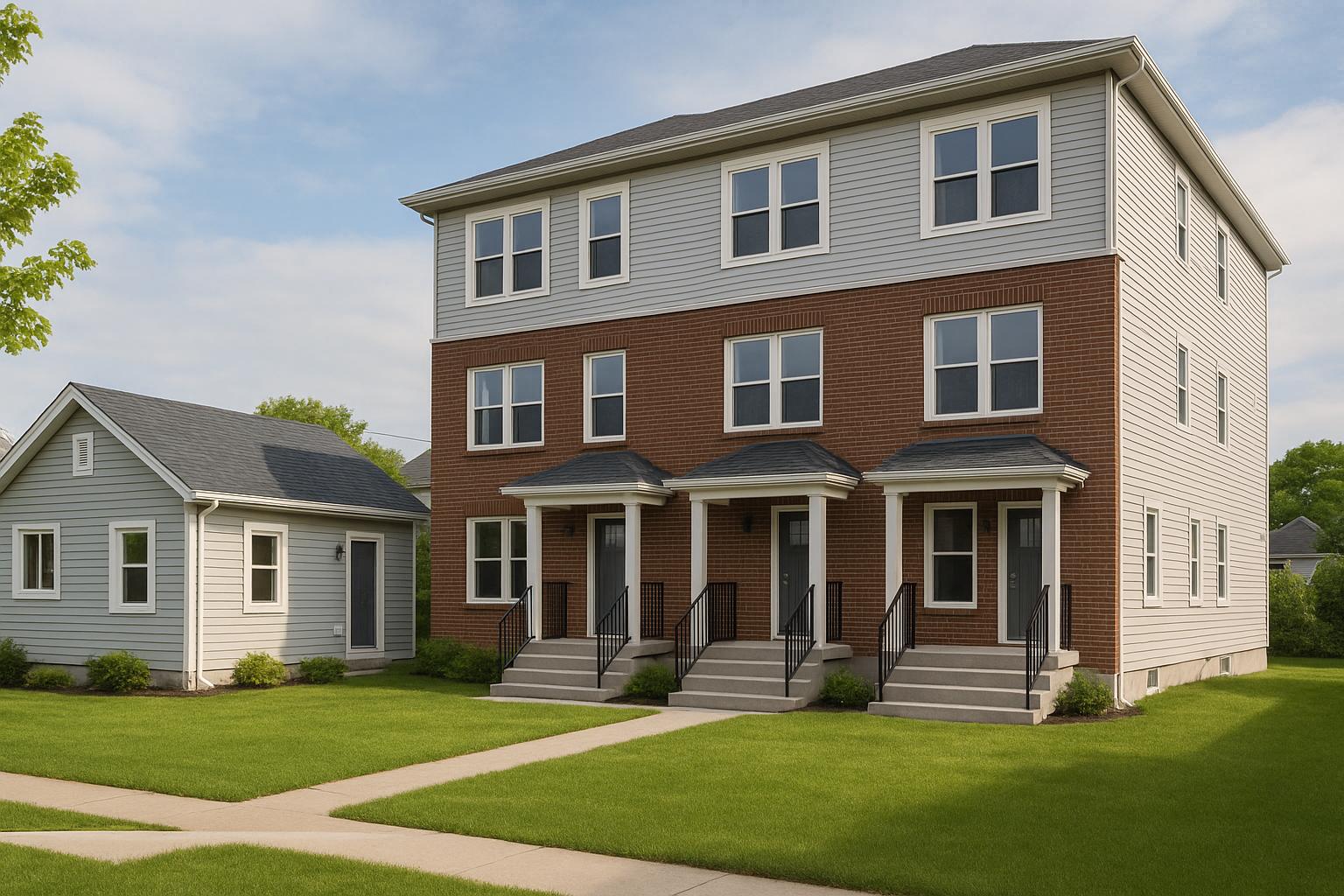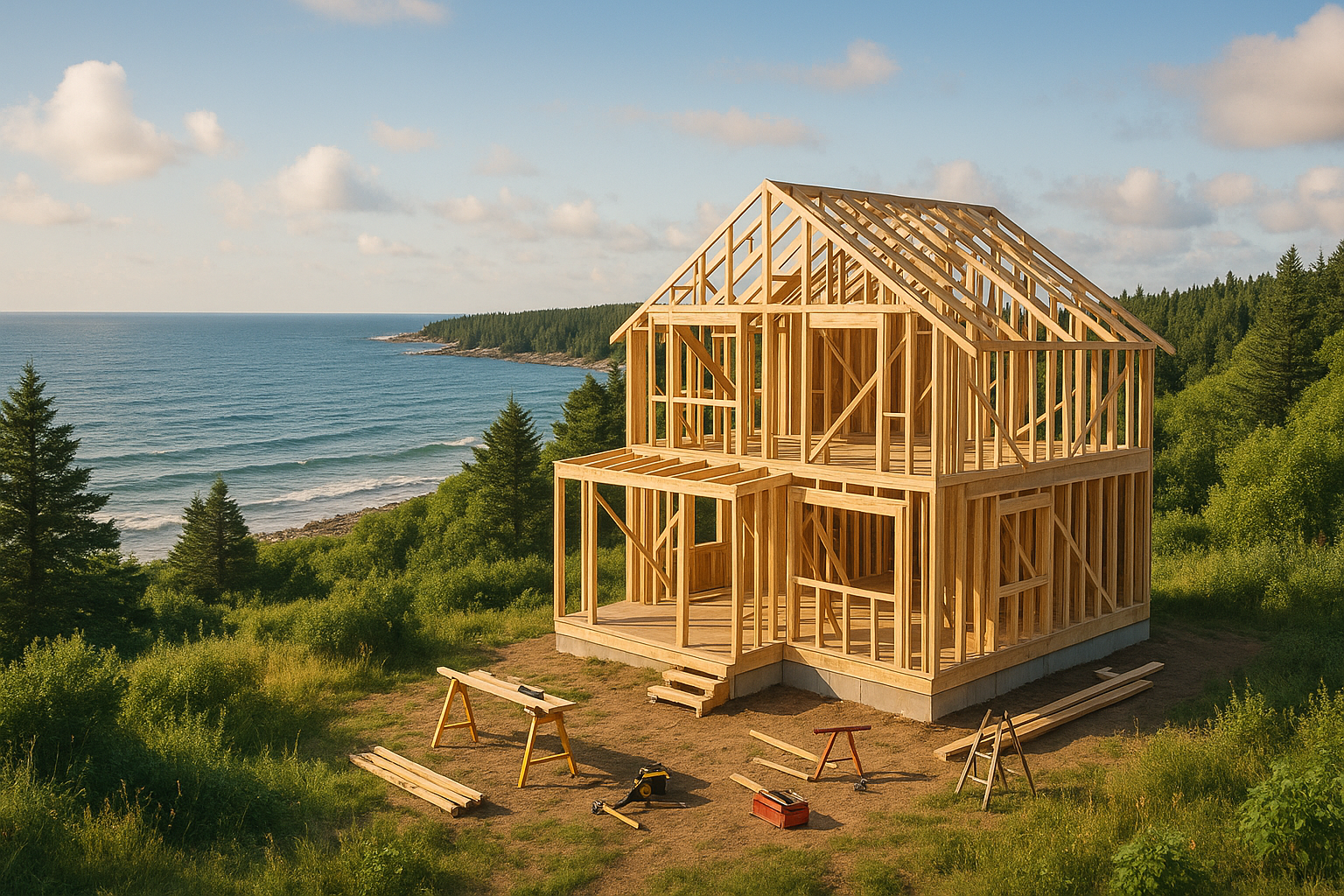When deciding between a duplex, triplex, or fourplex in Nova Scotia, your choice depends on your budget, property size, and investment goals. Here’s a quick breakdown:
- Duplex: Lower construction costs (~$320,000) and simpler to build. Generates ~$3,900–$4,200 monthly from two units. Easier to manage but more sensitive to vacancies.
- Triplex: Moderate costs (~$480,000) with higher income potential (~$5,850–$6,300 monthly). Offers better vacancy protection than a duplex.
- Fourplex: Higher upfront costs (~$640,000) but maximizes rental income (~$7,800–$8,400 monthly). Spreads vacancy risk across four units and benefits from economies of scale.
Key factors:
- Budget: Duplexes are affordable, while fourplexes require more capital but yield higher returns.
- Lot Size: Duplexes fit smaller lots; fourplexes need larger spaces.
- Vacancy Risk: Fourplexes reduce income loss during tenant turnover.
- Construction Complexity: Duplexes are simpler; fourplexes need careful planning.
Quick Tip: Check zoning rules early to ensure your lot fits the project type.
Quick Comparison:
| Factor | Duplex | Triplex | Fourplex |
|---|---|---|---|
| Construction Cost | ~$320,000 | ~$480,000 | ~$640,000 |
| Monthly Income | ~$3,900–$4,200 | ~$5,850–$6,300 | ~$7,800–$8,400 |
| Vacancy Impact | 50% income loss | 33% income loss | 25% income loss |
| Lot Size | Smaller lots | Medium-sized lots | Larger lots |
| Zoning Complexity | Low | Medium | High |
Choose based on your financial capacity, property’s potential, and long-term rental goals.
Advantages and Disadvantages of Owning a Duplex, Triplex or Fourplex
1. Duplex
A duplex consists of two separate rental units within a single building. For property owners in Nova Scotia, this type of property strikes a good balance between manageable construction requirements and reliable rental income potential.
Construction Costs
Building a duplex is often simpler than tackling larger multi-unit projects. The shared structure reduces the complexity of construction, cutting down on site preparation and utility upgrades. Since both units are housed within the same building, coordinating the work is more straightforward, often requiring fewer contractors and less time to complete. This streamlined process makes duplexes a practical choice for many residential lots in Nova Scotia, where demand for rental housing remains strong.
Rental Demand and Income
Duplexes are particularly appealing to tenants who value a mix of space and privacy. Young professionals and small families often gravitate toward these properties because they typically offer separate entrances and private outdoor spaces. This design caters to a wide range of renters, leading to steady occupancy rates and consistent rental income for property owners.
Site Suitability
One of the advantages of duplexes is their adaptability to various lot sizes and configurations. Many residential lots in Nova Scotia can easily accommodate a duplex while still adhering to local setback and parking regulations. Zoning requirements for duplex construction are usually straightforward, with most residential areas permitting these projects without lengthy approval processes. Additionally, standard residential utility services are often sufficient, which helps keep infrastructure costs manageable.
Financial Returns
Duplexes offer a combination of steady income and flexible financing options, making them an attractive investment. With two rental units, owners can benefit from income diversification; if one unit is vacant, the other can help cover expenses. Financing for duplexes is often treated similarly to single-family homes, making it easier to secure a mortgage. Over time, duplexes in desirable locations tend to increase in value, adding to their long-term investment appeal. For property owners in Nova Scotia, these financial benefits align well with the goal of building sustainable wealth through real estate.
2. Triplex
A triplex consists of three separate living units within one building. In Halifax and surrounding regions, the combination of rapid population growth and a thriving economy has created a strong demand for rental properties. This makes triplexes a solid choice for generating rental income. They also carry forward the balance of practicality and income stability seen with duplexes.
Rental Demand and Income
Having three units offers a buffer against vacancies. If one unit becomes vacant, the rent from the other two can help maintain a steady cash flow. This setup reduces financial risks and aligns well with strategies designed to manage construction challenges and unpredictable costs.
sbb-itb-16b8a48
3. Fourplex
A fourplex is a popular choice for property owners in Nova Scotia looking to boost rental income while keeping construction manageable. With four separate units under one roof, it offers a great balance between profitability and minimizing vacancy risks.
Construction Costs
Building a fourplex requires a higher upfront investment compared to smaller properties, but it often delivers better value per unit. Thanks to economies of scale, the average construction cost in Nova Scotia is about $160,000 per unit, amounting to a total of $640,000. This is often more cost-effective than constructing individual homes or smaller multi-unit buildings when you break it down per rental unit.
That said, the construction process for a fourplex is more complex. With multiple trades and systems to coordinate, it’s crucial to have a well-organized team to avoid budget overruns and delays.
Rental Demand and Income
Fourplexes generate solid and stable rental income. In Halifax’s competitive rental market, a 2-bedroom unit typically rents for $1,950 to $2,100 per month, which means a single fourplex can bring in between $7,800 and $8,400 monthly. This level of income often translates into annual returns of 12–20%, making it a strong investment option.
Another advantage is the reduced risk of vacancies. With four units, even if one tenant moves out, the remaining three can maintain cash flow, offering a level of stability that smaller properties can’t match.
Site Suitability
Building a fourplex requires a larger lot and must comply with local zoning regulations. Fortunately, many areas within a 90-minute radius of Halifax are zoned for four-unit buildings, but it’s essential to confirm specific requirements with your municipality. The structure’s footprint and parking needs mean you’ll also need ample space for both the building and tenant parking.
While site preparation costs can be higher due to the building's size, these expenses are spread across four units, making them more manageable on a per-unit basis. Proper site planning directly impacts the overall success of your investment.
Financial Returns
The numbers make a strong case for fourplexes. With construction costs around $640,000 and potential monthly rental income exceeding $8,000, the returns often justify the larger initial investment. However, keeping the project on budget and on schedule is key to protecting those returns.
Fourplexes also benefit from economies of scale, which lower the per-unit construction cost compared to building separate properties. Additionally, managing all four units in one location simplifies property management, saving both time and money in the long run.
Advantages and Disadvantages
When considering multi-unit properties, each option comes with its own set of trade-offs that can shape your investment strategy. The table below highlights key metrics, followed by insights that delve deeper into these factors.
| Factor | Duplex | Triplex | Fourplex |
|---|---|---|---|
| Construction Cost | ~$320,000 (about $160,000 per unit) | ~$480,000 | ~$640,000 |
| Monthly Rental Income | ~$3,900–$4,200 (2 units × $1,950–$2,100) | ~$5,850–$6,300 (3 units × $1,950–$2,100) | ~$7,800–$8,400 (4 units × $1,950–$2,100) |
| Vacancy Risk | One vacancy = ~50% income loss | One vacancy = ~33% income loss | One vacancy = ~25% income loss |
| Construction Complexity | Simpler coordination | Moderately complex | More complex, benefits from integrated planning |
| Zoning Requirements | Often broadly permitted | May face parking and density challenges | Typically needs municipal approval |
| Site Requirements | Smaller lot acceptable | Medium-sized lot preferred | Larger lot necessary |
| Management Effort | Fewer tenants, lower management needs | Additional attention required | Higher tenant volume but central location can improve efficiency |
| Financing Options | Standard residential financing | May mix commercial/residential terms | Often requires commercial lending |
Financial Return Patterns
Smaller projects, like duplexes, require less upfront investment but are more vulnerable to income loss during vacancies. On the other hand, larger builds, such as fourplexes, spread the risk across multiple units, making them less sensitive to gaps in occupancy. Fourplexes often achieve annual returns in the 12–20% range, thanks to economies of scale that reduce costs per unit and minimize the financial impact of vacancies.
Construction and Regulatory Considerations
The size of your project directly impacts the regulatory hurdles you’ll face. Duplexes tend to have fewer zoning restrictions and are usually approved more easily on appropriately zoned land. Triplexes, however, may encounter stricter requirements, such as parking and density standards. Fourplexes typically demand a more thorough municipal review process, including early confirmation of zoning compliance. Larger builds also require detailed inspections and careful project management to avoid budget overruns, adding to their complexity.
Risk and Reward Balance
Larger multi-unit properties offer better protection against income loss during tenant transitions, as the impact of a single vacancy is spread across more units. While smaller projects like duplexes often have more predictable construction timelines, larger builds can present added challenges. These include the need for integrated planning and oversight to handle the complexities of construction and tenant management effectively.
Long-term Investment Implications
Managing multiple units in a single location simplifies operations and can enhance your market position as a rental property owner. A fourplex, for instance, consolidates all units in one building, making it easier to manage tenants and streamline maintenance. This setup can also strengthen your standing with lenders and other professionals as you expand your portfolio. For investors in Nova Scotia’s rental market, aligning these efficiencies with your long-term strategy could be a smart move, especially as the demand for rental properties continues to evolve.
Making Your Decision
Deciding between a duplex, triplex, or fourplex boils down to three key considerations: your budget, risk tolerance, and long-term investment goals. Each option suits different types of property owners, so understanding your priorities will help steer you in the right direction. Let’s break it down to find the best fit for your needs.
Start with your budget. Your financial capacity will largely determine the scale of your project. Duplexes are often the simplest choice, with monthly rental incomes ranging from $3,900 to $4,200. They offer a manageable entry point into property management while generating steady returns. However, don’t overlook the potential impact of vacancies on your cash flow - planning for this is essential.
Evaluate your property’s potential. Local zoning laws and lot size can quickly narrow your options, sometimes even before financial considerations come into play. Check municipal regulations early in the process to avoid surprises later.
Weigh the stability of rental income. If minimizing income fluctuations is a priority, fourplexes are worth considering. With four units, each accounts for just 25% of your total rental income, offering a buffer against vacancy losses. This stability is particularly helpful during periods of tenant turnover. On the flip side, fourplexes require a bigger upfront investment and more complex construction coordination.
Factor in your construction timeline. Smaller projects like duplexes tend to encounter fewer delays and coordination issues. In contrast, larger builds, such as fourplexes, benefit from streamlined, design-build approaches that can help reduce delays. If you’re planning a larger project, look for contractors who offer fixed-price agreements with guaranteed timelines. Cost overruns - often ranging from 30% to 60% - can seriously impact your returns.
Think about your long-term goals. If this is your first foray into rental property investment, consider how your choice will prepare you for future opportunities. Managing four units in a single building provides valuable experience in tenant relations, maintenance, and cash flow management - skills that will serve you well as you grow your portfolio.
Understand your financing options. Financing requirements differ depending on the size of the project. Duplexes typically qualify for standard residential loans, while fourplexes may require commercial lending. Be sure to account for these financing differences when calculating your total project costs, not just construction expenses. For some, the cost efficiencies of building a fourplex can outweigh the higher borrowing costs.
Ultimately, your decision should align with your investment style. If you prefer a conservative approach, duplexes offer simplicity and lower upfront costs. On the other hand, those aiming for growth often lean toward fourplexes for their stronger cash flow and operational advantages. Tailor your choice to your financial situation, timeline, and goals within Nova Scotia’s rental market. This way, your investment not only meets your current capabilities but also sets the stage for future success.
FAQs
What zoning rules should I know before building a duplex, triplex, or fourplex in Nova Scotia?
Before you break ground on a multi-unit property in Nova Scotia, make sure you understand the zoning classification of your land - whether it's R-2, R-3, or another designation. This will determine if duplexes, triplexes, or fourplexes are allowed. Also, verify the maximum number of units permitted and check for any specific restrictions, like rules against ground-floor commercial spaces. Keep in mind that zoning regulations can change, so it's crucial to review the latest municipal bylaws and zoning maps. If you're unsure about any details, reaching out to a local planning expert can help you avoid delays and ensure everything is done by the book.
What are the long-term financial benefits of building a fourplex compared to a duplex or triplex in Nova Scotia?
Fourplexes often deliver stronger financial rewards over time compared to duplexes or triplexes. This mainly stems from their higher rental income potential and the cost efficiencies that come with managing more units under one roof. While duplexes are generally less expensive upfront and easier to oversee, fourplexes can bring in much greater income, making them an attractive option for property owners looking to boost rental profits.
That said, fourplexes do come with some trade-offs, such as a larger initial investment and greater management demands. Still, these challenges are often outweighed by the long-term benefits, particularly in Nova Scotia's expanding rental market. For those prioritizing steady growth and consistent cash flow, a fourplex can be a highly rewarding investment.
What makes managing a fourplex more complex than a duplex, and how can property owners handle these challenges effectively?
Managing a fourplex comes with its own set of challenges compared to a duplex. With more tenants to manage, maintenance needs increase, and juggling the operations of multiple units can demand significantly more time and effort. These factors can directly impact your cash flow and overall workload as a property owner.
To navigate these complexities, it’s wise to implement organised management strategies. This might include setting up regular maintenance routines, maintaining clear and open communication with tenants, and addressing repairs promptly to avoid escalating issues. If the workload feels overwhelming, bringing in a professional property management service could be a game-changer. They can help streamline daily operations, minimise the risk of vacancies, and create a smoother experience for both you and your tenants.



